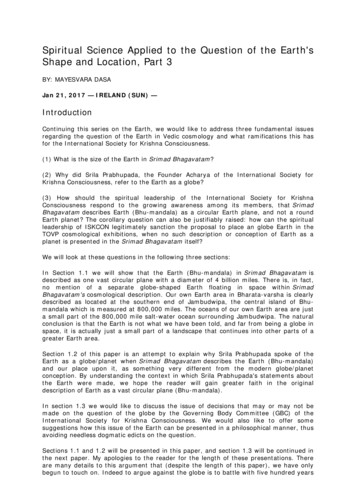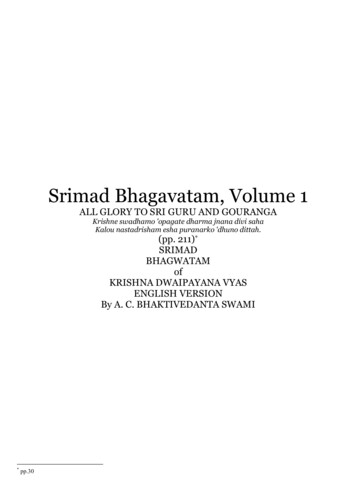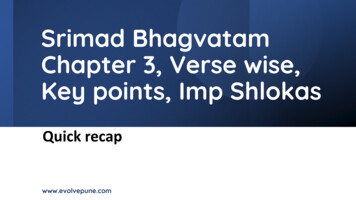
Transcription
Next
Srimad bhagavatam pdfSrimad bhagavatam pdf. Srimad bhagavatam iskcon. Srimad bhagavatam class. Srimad bhagavatam canto 1. Srimad bhagavatam in tamil. Srimad bhagavatam pdf hindi. Srimad bhagavatam iskcon price. Srimad bhagavatam canto 1 pdf.Avatar (Incarnation Number) Description Function Canto Kumaras (1) Sanaka, Sanatana, Sanandana and Sanatkumara Revive spiritual truth 1, 3, 4 Varaha (2) Boar Lift the Earth out of the cosmic ocean (Garbhodaka) 3 Narada (3) Sage Expound Vedic Knowledge -- Nara-Narayana (4) Twins Demonstrate austerity and penance (Prāyaścitta) 4 Kapila(5) Sage Expound Sankhya Philosophy[49] 3 Dattatreya (6) Trimurti Guru Expound renunciation (Sannyasa) 4 Yajna (7) Personification of sacrifice Expound sacrifice (Yajna) Rsabha (8) First Tirthankara of Jainism Expound Japa Yoga (materialistic yoga) 5 Prthu (9) First consecrated king Rule over the Earth in abundance 4 Matsya (10) Fish Shelterfrom the vast water at the end of the millennium 8 Kurma (11) Tortoise Pivot for Mandara Mountain used as a churning rod 8 Dhanvantari (12) God of Ayurvedic medicine Inaugurate medical science 8, 9 Mohini (13) Female; represents seductive illusion Delude demons - and later Shiva - through seduction (maya) 8 Nrsimha (14) Half lion, half manKill Hiranyakasipu 7 Vamana (15) Dwarf Take away all the lands of Bali in three steps 8 Parashurama / Bhrgupati (16) Warrior Uproot unwanted rulers (21 times) 9 Vyasadeva (17) Compiler of Vedic scriptures Divide Vedic knowledge to make it easier to understand -- Rama / Ramachandra (18) Incarnation in previous Treta Yuga Destroy Ravana 9Balarama (19) Krishna's brother Diminish the burden of the Earth from asuras 10 Krishna (20) Transcendental source of all Diminish the burden of the Earth from asuras 1, 10, 11 Buddha (21) Founder of Buddhism Expound impersonal philosophy to atheists Kalki (22) Supreme Chastister Appear at the end of Kali Yuga to destroy evil 12 HayagrivaHalf-horse, half-man; personification of Vedas and Sacrifices Revive Vedic knowledge and sacrifice (Yajna) 2, 5 Hamsa Swan Revive Vedic knowledge 11 Aniruddha Grandson of Krishna, son of Pradyumna Diminish the burden of the Earth from asuras 10 Pradyumna Son of Krishna; avatar of Kamadeva (an avatar of Vishnu) Diminish the burden of theEarth from asuras 10 Samba Son of Krishna Diminish the burden of the Earth from asuras 10 Suyajna (Hari) Son of Prajapati Diminish misery; beget Demigods (e.g. Indra) with Daksina 7 Manu Descendant of the ruling Manu dynasty Rule over the miscreant kingly order (Kshatriyas) 3 Ananta / Sankarsana / Shesha / Tamasi Transcendental serpentworshipped by Shiva Support and destroy the universe 5 Ajita Appeared to churn the ocean of milk Churn the ocean of milk 8 Notable devotees The table below does not include devotee avatars of Vishnu such as Narada, Kapila, or Prthu. You are the supreme soul who appear as the universe by means of your various powers (such as Sattva, Rajas andTamas). Tales for the dying: the death narrative of the Bhāgavata-Purāṇa. Matchett, Freda (2001). 29 March 2012. Like the tenth canto, it has also been translated and published separately, usually as a companion or 'sequel' to the Bhagavad Gita.[89][90] 'Hamsa' means 'swan' or 'spirit',[91] and: Is the name of the single class or order of society inSatya Yuga (as compared to four in Kali Yuga), the first and purest of the four cyclical yugas[92] Symbolises Brahman (Ultimate Truth, Self, or Atman) in Hinduism[93] Is the mount ridden by Brahma Is the name of the tenth (i.e. swan) avatar of Krishna that taught the Vedas to Brahma (hence the symbolism of the swan being ridden by Brahma as amount). He will be a servant to those who know about the Brahman.— Fourth Skandha, Chapter 4(16)[63] Fifth Canto Rsabha. "Canto 9: Liberation". From the K.L. Joshi (editor) translation: The following are the five characteristics of the Puranas: They describe (1) the creation of the universe, (2) its genealogy and dissolution, (3) the dynasties, (4)the Manvantaras, (5) the dynastic chronicles. Then real devotion and devotional service begin.— Canto 3, Chapter 25, Verse 25[59] J.M. Sanyal translation: They are so earnest and eagerly attached to mutual discussion on the holy glories of God that the limbs of their bodies become paralysed on account of their being devoid of sensibility due to theirzeal for discourses on the illustrious Lord; and so they are possessed of the crowning virtue of kindness which is desired by all good people.— Book 3, Chapter XV, Verse 25[60] Fourth Canto Vishnu appears before Dhruva Consisting of 31 chapters,[61] the fourth canto continues the dialogues of Sukadeva Gosvami, Uddhava, and Maitreya. Retrieved18 November 2019. "Siddhis in the Bhāgavata Purāṇa and in the Yogasutras of Patanjali – a Comparison". It is like the sun and is full of knowledge about dharma.— The Bhagavata Purana 1, First Skandha, Chapter 1(3) (SB 1.3.43)[32] A unique and especial emphasis is placed on fostering transcendental loving devotion to Krishna as the ultimategood, i.e. for its own sake rather than for fruitive results or rewards such as detachment or worldly or heavenly gains, a practice known as Bhakti Yoga:What makes the Bhagavata unique in the history of Indian Religion. It emerged from Shuka's mouth, with the pulp and juice of amrita. Shelat, 1999; vol. Bhaktivedanta Swami (31 December 1984).SB 1.1.3 original Sanskrit::Swami Prabhupada translation: O expert and thoughtful men, relish Srimad-Bhagavatam, the mature fruit of the desire tree of Vedic literatures. Edwin Bryant (2004), Krishna: The Beautiful Legend of God:Srimad Bhagavata Purana Book X, Penguin, ISBN 978-0140447996 Sources Beach, Milo Cleveland (1965). pp. 217–226. After being thrown out of his home by King Dhritarashtra (his older half-brother) for admonishing the Kaurava's ignoble behaviour towards the Pandavas, Vidura went on a pilgrimage where he met other devotees of Krishna such asUddhava and the sage Maitreya; their dialogues form a third layer of narration. p. 76. Cambridge University Press. Doniger, Wendy, ed. Motilal Banarsidass Publishers. Rocher 1986, pp. 138–151 Ravi Gupta and Kenneth Valpey (2013), The Bhagavata Purana, Columbia University Press, ISBN 978-0231149990, pages 3-19 Constance Jonesand James Ryan (2007), Encyclopedia of Hinduism, Infobase, ISBN 978-0816054589, page 474 Kumar Das 2006, p. 174 Barbara Holdrege (2015), Bhakti and Embodiment, Routledge, ISBN 978-0415670708, page 114 a b Barbara Holdrege (2015), Bhakti and Embodiment, Routledge, ISBN 978-0415670708, pages 109-110 a b "ŚB 1.3.40". Thesecond layer of overarching narration begins as a dialogue between Sukadeva Gosvami and Pariksit on the banks of the Ganges river (narrated by Sukadeva Gosvami to a group of sages headed by Saunaka in the forest of Naimisaranya). Consisting of 15 chapters,[70] the seventh canto continues with the dialogue between Sukadeva Gosvami andPariksit on the banks of the Ganges river. ISBN 978-81-208-1861-3. ISBN 9788171103065. A study of the Bhagavata Purana; or, Esoteric Hinduism. The earth, air, and space, Water and fire, The sun and moon, The dove and the python, The sea, The moth and the bee, And the elephant. Focusing on the female descendants of Svayambhuva Manu,topics covered include the: Genealogies of the daughters of Svayambhuva Manu and of Dhruva (grandson of Svayambhuva Manu) Enmity between Daksa and Shiva, self-immolation of Sati (wife of Shiva and daughter of Daksa), and attack by Shiva on Daksa's ritual Liberation of the boy-sage Dhruva, including advice from Narada, his vision of Vishnu,and battles with the Yaksas Killing of the tyrant-king Vena by Brahmins before the appearance of the Prthu avatar to restore abundance of the Earth Allegorical story, descriptions, and characteristics of King Puranjana, who was reborn as a woman due to thinking of his wife when he died Activities of the Pracetas, including meeting with Shiva,instruction from Narada, and ultimate liberation Qualities of Krishna, Vaishnava devotion (Bhakti Yoga), the soul (atman), the super-soul (paramatman), and materialistic life SB 4.16.17 original Sanskrit::::Swami Prabhupada translation: The king[Prthu] will respect all women as if they were his own mother, and he will treat his own wife as the other half of his body. Publication Division, Ministry of Information and Broadcasting, Government of India. p. 11. — Sūta, Bhagavata Purana 1.2.10-11, Translated by Daniel Sheridan[105] Scholars describe this philosophy as built on the foundation ofnon-dualism in the Upanishads, and term it as "Advaitic Theism".[8][106] This term combines the seemingly contradictory beliefs of a personal God that can be worshiped with a God that is immanent in creation and in one's own self. They attacked themselves and he sought to reduce the burden of the earth.— Ninth Skandha, Chapter 9(24)[78] TenthCanto Consisting of 90 chapters,[79] the tenth canto continues the dialogue between Sukadeva Gosvami and Pariksit on the banks of the Ganges river. A history of Indian philosophy. Contrary to the western cultural tradition of novelty, poetic or artistic license with existing materials is a strong tradition in Indian culture,[44] a 'tradition of severalhundred years of linguistic creativity'.[45] There are variations of original manuscripts available for each Purana, including the Srimad Bhagavatam.[44] The common manuscript for translations of the Bhagavata Purana - seemingly used by both Swami Prabhupada and Bibek Debroy- is the Bhāgavatamahāpurāṇam (Nag Publishers, Delhi),[46] areprint of Khemraj Shri Krishnadas' manuscript (Venkateshvara Press, Bombay).[43] In regards to variances in Puranic manuscripts, academic Dr. Gregory Bailey states: [S]ignificant are the widespread variations between manuscripts of the same Purana, especially those originating in different regions of India. This table is not exhaustive. Krishna:A Sourcebook. Let me tell you of my teachers. With the content remaining identical, the text may be counted as one shloka in one place and as two shlokas elsewhere. Vol. IV: Indian pluralism. The man who makes arrows And a certain serpent, The spider, and the insect Captured by the wasp. vedabase.io. Rocher, Ludo (1986). "ŚB 1.3.28". "Canto 8: Withdrawal of the Cosmic Creations". He is supreme ruler of the universe and the eternal refugee of all living beings. Parmeshwaranand, Swami (2001). Avatars featured or appearing repeatedly throughout the scripture are marked with "--" in the Canto column (except Krishna). It is meant for the ultimate good of all people, and it is allsuccessful, all-blissful and all-perfect.— Srimad Bhavagatam First Canto, Chapter 3, Verse 40[16] From the Bibek Debroy translation: This Purana has arisen now, in Kali yuga, when all learning has been destroyed, after Krishna returned to his own abode. "Canto 6: Prescribed Duties for Mankind". He is the supreme lord who alone conquers his owngunas. Shelat, and K. English The Śrīmad Bhāgavatam by A. Sanskrit:; Archive; KS Sastri (1975), Archive of Bhagavata Purana, Book 12 with 11 Sanskrit Commentaries,pages 337-341 a b c d e Rukmani 1993, pp. 217–218 Cutler 1987, p. 1 Bryant 2007, p. 117 Matchett 1993, p. 103 Matchett 1993, p. 104 Dasgupta 1949, p. 30 a b c d Sheridan 1986 Dasgupta 1949, p. 24 Sheridan 1986, p. 23 with footnote 17;Sanskrit: Source: Bhagavata Purana Archive Brown 1998, p. 17 a b Edwin Bryant (2004), Krishna: The Beautiful Legend of God: Srimad Bhagavata Purana Book X, Penguin, ISBN 978-0140447996, pages 43-48 Kumar Das 2006, p. 174 Paul Deussen, Sixty Upanishads of the Veda, Volume 1, Motilal Banarsidass, ISBN 978-8120814684, page 326 Max Muller, Shvetashvatara Upanishad, The Upanishads, Part II, Oxford University Press, page 267 Max Muller, The Shvetashvatara Upanishad, Oxford University Press, pages xxxiv and xxxvii Paul Carus, The Monist at Google Books,pages 514-515 Karen Pechilis Prentiss (2014), The Embodiment of Bhakti, Oxford University Press, ISBN 978-0195351903, page 17, Quote: "Scholarly consensus today tends to view bhakti as a post-Vedic development that took place primarily in the watershed years of the epics and Puranas." Norman Cutler (1987), Songs of Experience, IndianaUniversity Press, ISBN 978-0253353344, pages 1-5 Kumar Das 2006, pp. 173–175 Bryant 2007, p. 382 TR Sharma (1993), Psychological Analysis of Bhakti, Love Divine: Studies in Bhakti and Devotional Mysticism (Editor: Karel Werner), Routledge, ISBN 978-0-7007-0235-0, pages 103-107 a b c Ravi Gupta and Kenneth Valpey (2013), TheBhagavata Purana, Columbia University Press, ISBN 978-0231149990, pages 8-10, 30-32 a b Rāma Karaṇa Śarmā (1993), Researches in Indian and Buddhist Philosophy, Motilal Barnarsidass, ISBN 978-8120809949, pages 218-221 Rukmani 1993, pp. 220, 224 Bryant 2007, pp. 117–118 Bryant 2007, pp. 114 a b Tracy Pintchman (1994), Therise of the Goddess in the Hindu Tradition, State University of New York Press, ISBN 978-0791421123, pages 132-134 Sheridan 1986, pp. 17–21 Sheridan 1986, pp. 1–16 Matchett 2001, pp. 107 Gopal, Madan (1990). The Bhagavata Purana 2. p. 32. One should not jump to the conclusion that a large number of shlokas are missing [inDebroy's translation]. 3, skandhas 7-9, ed. Retrieved 26 December 2012. Topics covered include the: Details and ages of the four Manus (Svayambhuva, Svarocisa, Uttama, and Tamasa), and of the future Manus Elephant Gajendra, rescued from Makara the crocodile by Vishnu riding his mount Garuda, after prayers of surrender Battles between thedemigods and the demons, the truce brokered by Vishnu, and churning of the ocean of milk by both factions Appearance of the Kurma, Dhanvantari, Mohini, and Ajita avatars (and Lakshmi) during the churning of the ocean of milk Second appearance of Mohini to beguile Shiva Annihilation of the demons by Indra Appearance of the Vamana avatar totake back the three worlds from King Bali in three footsteps, and the surrender of Bali to Him Appearance of the Matsya avatar to save devotee-King Satyavrata from the flood (during the time of Hiranyaksa in the third canto) SB 8.5.30 original Sanskrit:Swami Prabhupada translation: No one can overcome the Supreme Personality of Godhead’s illusory energy [māyā], which is so strong that it bewilders everyone, making one lose the sense to understand the aim of life. The Bhaktivedanta Book Trust. "The Pervasiveness of Bhakti in the Bhāgavata Purāṇa".Consequently, by the arrangement of God, such demons, who possess great military strength, fight with one another, and thus the great burden of demons on the surface of the earth is reduced. Puranic Encyclopedia. University of California Libraries. J. respectively by H. ISBN 978-81-7041-859-7. ISBN 9780231542340. "Canto 7: The Science ofGod". by H. Ravi Gupta and Kenneth Valpey (2013), The Bhagavata Purana, Columbia University Press, ISBN 978-0231149990, pages 157-159 John Holt (2004), The Buddhist Visnu, Columbia University Press, ISBN 978-0231133227, pages 13-31 Ludo Rocher (1986), The Puranas, Otto Harrassowitz Verlag, ISBN 978-3447025225, pages 110111 Gail Adalbert (1968), Buddha als Avatara Visnus im Spiegel der Puranas, Deutscher Orientalistentag, Vol. Towards his subjects, he will be as gentle as a father. Haberman & Rūpagōsvāmī 2003, p. 65 Usha Sharma (2008), Festivals In Indian Society, Mittal, ISBN 978-8183241137, page 177 Selina Thielemann (1998), Sounds of the SacredMusic in India, APH, ISBN 978-8170249900, pages 96-98 "Bhadra Campaign 2020". Robert Van Voorst (2007). Some of the text's legends have inspired secondary theatre literature such as the eroticism in Gita Govinda.[153] While Indian dance and music theatre traces its origins to the ancient Sama Veda and Natyasastra texts,[154][155] the
Bhagavata Purana and other Krishna-related texts such as Harivamsa and Vishnu Purana have inspired numerous choreographic themes.[156] Many 'Ras' plays dramatise episodes related in the Rasa Panchadhyayi ("Five chapters of the Celestial Dance"; Canto 10, Chapters 29–33) of the Bhagavatam.[157] The Bhagavatam also encourages theatricalperformance as a means to propagate the faith (BP 11.11.23 and 36, 11.27.35 and 44, etc.), and this has led to the emergence of several theatrical forms centred on Krishna all across India.[158] Canto 10 of Bhagavatam is regarded as the inspiration for many classical dance styles such as Kathak, Odissi, Manipuri and Bharatnatyam.[159] Bryantsummarizes the influence as follows, The Bhagavata ranks as an outstanding product of Sanskrit literature. Name Description Canto Asvatthama Killed the sleeping children of Draupadi and attempted to kill the unborn Pariksit, son of Uttara 1 Hiranyaksa and Hiranyakasipu Demonic twin-sons of Diti; first incarnations of Jaya and Vijaya cursed by theFour Sanas / Kumaras 1, 3, 7 Vena Corrupt and evil king that caused famines; cursed by brahmanas to die before the appearance of Prthu 4 Vrtrasura Demon King (also a pure devotee) that defeated the Demigods, led by Indra 6 Bali / Mahabali Demon King (a Pure devotee) that conquered the three worlds; Vamana took them back in three footsteps 8Ravana and Kumbhakarna Demonic enemies of Rama (see Ramayana); second incarnations of Jaya and Vijaya 7, 9 Kamsa Tyrant King that imprisoned Krishna's parents, murdered Krishna's siblings, and attempted to kill Krishna 10 Putana Demon sent by Kamsa to poison baby Krishna 10 Trnavarta Whirlwind demon sent by Kamsa to kill baby Krishna10 Aghasura Gigantic serpent demon sent by Kamsa to kill boy Krishna 10 Bakasura Gigantic heron demon that swallowed boy Krishna 10 Dhenuka Donkey demon, ruler of the Talavana forest near the Yamuna river 10 Kaliya Naga (serpent) that poisoned Kaliya Lake and Krishna's cowherd friends 10 Pralamba Demon sent by Kamsa, disguised as acowherd boy 10 Aristasura Bull demon, attacked Krishna's cowherd community 10 Kesi Horse demon sent by Kamsa to kill young Krishna 10 Vyomasura Demon sent by Kamsa, disguised as a cowherd boy abducted Krishna's cowherd friends 10 Kuvalayapida Drunken and mad Elephant goaded to kill Krishna on behalf of Kamsa at a wrestling arena 10Jarasandha Kamsa's father-in-law; laid siege to Mathura with 23 armies before Krishna established Dvaraka 10 Kalayavana Barbarian King and ally of Jarasandha; tricked by Krishna into kicking Mucukunda and waking him 10 Shishupala and Dantavakra Maternal cousins and kings; cousins and enemies of Krishna; third incarnations of Jaya and Vijaya7, 10 Rukmi King and brother of Rukmini; wanted her to marry Shishupala, not Krishna; cheated Balarama at dice 10 Narakasura Demon that kidnapped 16,000 princesses; Krishna rescued and married them all 10 Banasura Demonic son of Bali who captured Aniruddha; saved by his naked mother from being killed by Krishna 10 Paundraka King thatimitated Krishna and challenged his position as the Supreme Personality of Godhead 10 Dhvivida Gorilla friend of Narakasura; for revenge, raped and terrorised people in Krishna's province 10 Salva Demonic King, friend of Shishupala and Dantavakra, and an illusionist; attacked Krishna's city, Dvaraka 10 Viduratha Brother of Dantavakra; attemptedto avenge his brother by attacking Krishna with a sword 10 Balvala Demon that had been polluting a sacrificial arena at the holy Naimisaraya forest 10 Bhasmasura Demon given a boon by Shiva to kill anyone whose head he touched; tried to kill Shiva with that boon 10 Kartavirya Arjuna A tyrant Kshattriya rule of the Haihaya clan; Parashurama killedhim fr forcibly abducting the Kamadhenu cow.: The Bhāgavatamahāpurāṇam (in Sanskrit). New Delhi: Anmol Publications. The Devī Gītā: the song of the Goddess; a translation, annotation, and commentary. Datta, Amaresh (2006). Shastri, 1996; vol. He will treat his own wife likeone half of his own self. There are additional layers of dialogue, such as between the sage-avatar Narada and King Pracinabharhisat (as narrated by Maitreya to Vidura). the layered arrangement of dialogues, in which a speaker (typically Suka, the main reciter, addressing his interlocutor, King Pariksit) quotes an "earlier" speaker (for example,Narada, addressing King Yudhisthira, Pariksit's granduncle, in a dialogue understood to have taken place earlier and elsewhere), who may in turn quote yet another speaker. He controls beings, without any partiality.— Eighth Skandha, Chapter 8(5)[75]In 7th chapter of eighth canto mentioned Lord Shiva is also non different from Brahman. He will bejust like an affectionate father to his citizens, and he will treat himself as the most obedient servant of the devotees, who always preach the glories of the Lord.— Canto 4, Chapter 16, Verse 17[62] Bibek Debroy translation: He will revere other men's wives like his own mother. ISBN 9781570034497. 9 Notable demons and villains Many demons(villains) are mentioned throughout the Srimad Bhagavatam; cantos listed concern their primary (or only) appearances and/or descriptions. Therefore this fruit has become even more tasteful, although its nectarian juice was already relishable for all, including liberated souls.— Canto 1, Chapter 1, Verse 3[50] Bibek Debroy translation: The sacredtexts are like trees that yield all the objects of desire and this represents their ripened fruit. Sri Chaitanya Saraswat Math. ISBN 9780140447996. "The Origin and Transmission of the Two "Bhāgavata Purāṇas": A Canonical and Theological Dilemma". It is stated in canto 1, chapter 3, verse 28, "kṛṣṇas tu bhagavān svayam" which A.C. BhaktivedantaSwami Prabhupada translates as, "Lord Śrī Kṛṣṇa is the original Personality of Godhead."[24] 'Purana' (Sanskrit) means 'ancient' or 'old' (or 'old traditional history').[25] It also means 'complete' and 'completing'[25] in the sense that a Purana 'completes the Vedas'.[26] 'Maha' (Sanskrit) means 'great', 'large', or 'vast'.[27] 'Srimad' (or'Srimat', Sanskrit) means 'radiant', 'holy', 'splendid', or 'glorious',[28] and is an honorific religious title. Redington (English translation of Vallabha's commentary on the Rāsa-Panchyādhyāyi) The Bhagavata Purana; Book X by Nandini Nopani and P. (29 November 2016). Indiana University Press. "CHAPTER THREE". Thus focusing on theappearance and pastimes of Krishna, topics covered include the: Imprisonment of Krishna's parents (Vasudeva Anakadundubhi and Devaki), the murder of His siblings, and attempted murder of baby Krishna by King Kamsa Fostering of Krishna and Balarama by Nanda and Yashoda (Gopas, a tribe of cowherds); Yashoda saw the universal form in boyKrishna's mouth Attempts on baby and boy-Krishna's life by various demons, mostly sent by Kamsa (e.g. Putana, Trnavarta, Aghasura, Pralamba, Kesi, etc.) Chastisement of Kaliya, swallowing of a forest fire, lifting of Govardhana Hill, stealing of Gopis' clothes, and the Rasa dance Defeat of numerous demonic foes (e.g. Kamsa, Jarasandha, Kalayavana,Narakasura, Paundraka, etc.) to diminish the burden of the Earth Marriages to over 16,000 wives (and children with each), establishment of Dvaraka, return of the Syamantaka Jewel, and washing of Narada's feet Defeat of Banasura and Shiva, daily activities, blessing of Sudama, blessing of His devotees, saving of Shiva from Vrkasura, and summaryof glories SB 10.90.50 original Sanskrit::Disciples of Swami Prabhupada translation: By regularly hearing, chanting and meditating on the beautiful topics of Lord Mukunda with ever-increasingsincerity, a mortal being will attain the divine kingdom of the Lord, where the inviolable power of death holds no sway. Indira Gandhi National Centre for the Arts (ed.). p. 123. Matsya Mahāpurāṇa: Chapters 1-150. Main article: Advaita Vedanta Kumar Das and Sheridan state that the Bhagavata frequently discusses a distinctly advaitic or non-dualisticphilosophy of Shankara.[5][8] Rukmani adds that the concept of moksha is explained as Ekatva (Oneness) and Sayujya (Absorption, intimate union), wherein one is completely lost in Brahman (Self, Supreme Being, one's true nature).[97] This, states Rukmani, is proclamation of a 'return of the individual soul to the Absolute and its merging into theAbsolute', which is unmistakably advaitic.[97] The Bhagavata Purana is also stated to parallel the non-duality of Adi Shankara by Sheridan.[8] As an example: The aim of life is inquiry into the Truth, and not the desire for enjoyment in heaven by performing religious rites, Those who possess the knowledge of the Truth, call the knowledge of nonduality as the Truth, It is called Brahman, the Highest Self, and Bhagavan. Rukmani, T. one of the principal characteristics of the genre is the status of Purana as what Doniger calls "fluid texts" (Doniger 1991, 31). There is a saying in Sanskrit - vidyā bhāgavatāvadhi - Bhāgavatam is the limit of one's learning. The main objective of this text is topromote Bhakti to Vishnu in his incarnation as Krishna referred to variously, and to illustrate and explain it. Prabhupada, Disciples of His Divine Grace A. He is accompanied by His associates, servants, weapons and confidential companions.— Canto 11, Chapter 5, Verse 32[134] Chaitanya is commonly referred to as 'Gauranga' in regards to Hisgolden complexion (as detailed in the Gauranga article, the Sanskrit word 'ākṛṣṇaṁ' means 'not blackish' and 'golden'), and is most notable for popularising the Hare Krishna maha-mantra. 'Mad' (or 'Mat', Sanskrit) means 'religion' or 'believed'.[30] Those with a wealth ('Sri') of religion ('mad') may be honoured with the title of 'radiant', 'holy','splendid', or 'glorious' ('Srimad'). Other scholars state that the great Purāṇas deal with these ten topics, while lesser Purāṇas may deal with five.— Canto 12, Chapter 7, Verses 9-10[40] Shlokas / verses Although the number of original Sanskrit shlokas is stated to be 18,000 by the Bhagavata itself[41] - and by other Puranas such as the Matsyamahapurana[42] - the number of equivalent verses when translated into other languages varies, even between translations into the same language and based on the same manuscript[43] The English translation by Bibek Debroy (BD), for example, contains 78 more verses than the English translation by A.C. Bhaktivedanta Swami Prabhupada / BBT,despite likely being based on the same manuscript:[43] Srimad Bhagavatam Chapters and Verses BBT Translation BD Translation Canto Chapters Verses % Chapters Verses % 1 19 808 5.7 19 811 5.7 2 10 393 2.8 10 391 2.8 3 33 1,416 10 33 1,412 10 4 31 1,449 10.3 31 1,450 10.2 5 26 668 4.8 26 738 5.2 6 19 851 6 19 855 6 7 15 750 5.3 15 752 5.38 24 931 6.6 24 929 6.6 9 24 960 6.8 24 962 6.8 10 90 3,936 27.9 90 3,948 27.9 11 31 1,367 9.7 31 1,360 9.6 12 13 565 4 13 564 4 Total 335 14,094 100 335 14,172 100 Difference (BBT/BD) -78 78 Difference (Sanskrit) -3,906 -3,828 In his discussion on the issue of varying numbers of verses in translations of the Srimad Bhagavatam, Debroy states:[T]here are unabridged translations [of the Bhagavata] in Indian languages. "ŚB 3.25.25". Retrieved 15 November 2019. Sonic theology: Hinduism and sacred sound. Sheridan, Daniel (1986). SUNY Press. Consisting of 24 chapters,[73] the eighth canto continues the dialogue between Sukadeva Gosvami and Pariksit on the banks of the Ganges river.These are dramatic enactments about Krishna's pastimes. a b "Sanskrit Dictionary for Spoken Sanskrit: 'purana'". Retrieved 21 October 2019. ISBN 9788187897194. "The Archaism of the Bhāgavata Purāṇa". Questioned by Pariksit, the topics covered by Suta Gosvami include the: Transcendental, supreme, eternal, and pure nature of KrishnaUniversal Virat-Rupa and Maha-Vishnu forms of Krishna, as well as His scheduled avatars with their purposes Process and laws of creation and annihilation of the universe God realisation, Bhakti Yoga, devotional duties, and the need for a spiritual master (Guru) Vedic knowledge, modes of material nature (gunas), karma, false (i.e. materialistic) ego,and illusion and suffering due to ignorance Divisions (caste or varna) of society, common religious affiliations, and faith versus atheism SB 2.5.35 original Sanskrit:::Swami Prabhupada translation: The lord Maha-Vishnu, although lying in the CausalOcean, came out of it, and dividing Himself as Hiranyagarbha, He entered into each universe and assumed the virat-rupa, with thousands of legs, arms, mouths, heads, etc.— Canto 2, Chapter 5, Verse 35[56] Bibek Debroy translation: Purusha split the egg and emerged, with thousands of thighs, legs, arms and eyes and thousands of mouths andheads.— Second Skandha, Chapter 2(5)[57] Third Canto Depiction of Brahma's anger and the origin of Shiva from the former's eyebrows, when the Four Kumaras decide immediately to perform penance before helping their father in creation. It emanated from the lips of Sri Sukadeva Gosvami. "ŚB 11.17.10". Twelfth Canto Kalki Consisting of 13chapters,[94] the twelfth and final canto completes the dialogue between Sukadeva Gosvami and Pariksit on the banks of the Ganges river, and ends with the overarching dialogue between Sukadeva Gosvami and the group of sages led by Saunaka, at the forest of Naimisaranya. English Swami Prabhupāda's version Bhaktivedanta Vedabase Gita Pressversion The Translation of Sankaradeva's Gunamala - the 'pocket-Bhagavata' (Assam version) Translation of Sankaradeva's Veda-Stuti (The Prayer of the Vedas), Bhagavata, Book X, from Sankaradeva's Kirttana Ghosa, the 'Bhagavata in miniature' Bhagavata Purana Research Project, Oxford University A prose English translation of SrimadBhagavatam, MN Dutt (Open access limited to the US and parts of Europe) Bhagavata Purana Research Project, (Srimad Bhagavatam English Version) Sanskrit original GRETIL etext: The transliterated Sanskrit text for the entire work Bhagavata Purana (Sanskrit) Searchable transliterated PDF file of the entire Bhagavata-Purana fromsanskritweb.net Retrieved from " Bryant states th
Srimad bhagavatam iskcon price. Srimad bhagavatam canto 1 pdf. Avatar (Incarnation Number) Description Function Canto Kumaras (1) Sanaka, Sanatana, Sanandana and Sanatkumara Revive spiritual truth 1, 3, 4 Varaha (2) Boar Lift the Earth out of the cosmic ocean (Garbhodaka) 3 Narada (3) Sage Expound Vedic Knowledge -- Nara-Narayana (4) Twins .










